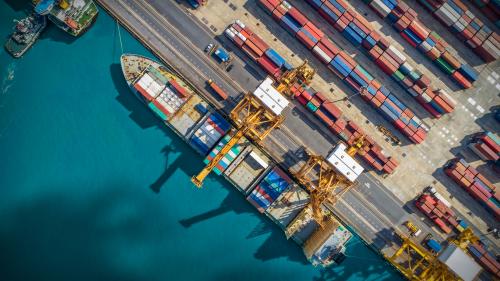The COVID-19 pandemic shone a spotlight on supply chains, with shortages in everything from baby formula to microchips. This spurred an on-going policy debate on the need for the U.S. to shore up its supply chains, in some cases literally moving production back to the U.S. or allied nations. However, new analysis published in the Brookings Papers on Economic Activity showed that effort may be more difficult than standard supply chain data suggests, especially when it comes to limiting exposure to China. In this episode, David Wessel, director of the Hutchins Center on Fiscal and Monetary Policy, interviews Rebecca Freeman of the Bank of England and Angelos Theodorakopoulos of Aston University on the “hidden exposure” that is revealed in U.S. supply chains with their new data.
- Listen to the Brookings Podcast on Economic Activity on Apple, Spotify, or wherever you like to get podcasts.
- Learn about other Brookings podcasts from the Brookings Podcast Network.
- Sign up for the podcasts newsletter for occasional updates on featured episodes and new shows.
- Send feedback email to [email protected].
Transcript
[music]
EBERLY: I’m Jan Eberly, James R. and Helen D. Russell Professor of Finance at Northwestern University.
STEINSSON: And I’m Jón Steinsson, Chancellor’s Professor of Economics at the University of California, Berkeley.
EBERLY: We’re the coeditors of the Brookings Papers on Economic Activity, a semiannual academic conference and journal that pairs rigorous research with real time policy analysis to address the most urgent economic challenges of the day.
STEINSSON: And this is the Brookings Podcast on Economic Activity, where we share conversations with leading economists on the research they do and how it will affect economic policy.
EBERLY: Today’s episode features an interview by David Wessel, director of Brookings’s Hutchins Center on Fiscal and Monetary Policy, with the authors of a new study, “Hidden Exposure Measuring U.S. Supply Chain Resilience.” The paper finds that U.S. manufacturers rely even more heavily on China than standard measures suggest, which means that decoupling of U.S.-Chinese supply chains that many have suggested is imminent may in fact, be much more difficult and expensive than previously thought.
STEINSSON: Yeah, I think this is a very important paper. One thing we woke up to during COVID is just how fragile and complex our global supply chains have become. Market economies are usually extremely good at avoiding shortages and bottlenecks. We all take this for granted on a daily basis. The things we want to buy are largely available at the stores we shop at. But during COVID, this all got disrupted and we realized that it’s not a law of nature. It relies on the smooth functioning of really complex supply chains. And these supply chains have been getting more and more complex over the past few decades.
EBERLY: And this team also brings some new data to the discussion. We saw a slowdown in trade during COVID, which has been quite persistent, but that does not tell us much about supply chains. To see that, which is the hidden exposure in the paper’s title, they need to measure where the supplies that go into the goods come from and how that’s changing over time. The paper addresses not only where goods are made, but where their supplies originate and how that may create risks to supply chains.
But it’s a subtle story because having foreign suppliers seen as a risk in some ways can also create resilience in other ways, say when domestic suppliers are at risk from a weather shock, for example. So, the paper provides new measurement of these complex linkages as well as a broader perspective on risk and policy.
[music]
So, let’s pass it over to David Wessel to hear more about this fascinating narrative.
WESSEL: Thank you, Jan and Jón. I’m here with two of the three authors of “Hidden Exposure”: Angelos Theodorakopoulos, assistant professor in economics at the Aston Business School, and Rebecca Freeman, a senior economist at the Bank of England who speaks for herself only and not for the Bank of England. So, if she says “we” during our conversation, she means herself, Angelos, and the third author of this paper, Richard Baldwin of IMD Business School.
So, welcome, Angelos.
THEODORAKOPOULOS: Thanks for having me today here.
WESSEL: And welcome to you, Rebecca.
FREEMAN: Thank you very much. It’s great to be here.
[00:03:38]
WESSEL: So, it used to be that the only people who worried about supply chains were logistics executives at manufacturing companies and retailers. Now, it seems to be on the lips of economic policymakers and chief executives around the world. Disruptions to supply chains seem to be blamed for everything from the unwelcome increase in inflation to the reason that you hear that there are renovations of your kitchen are behind schedule.
So, the authors of this paper take a close look at measuring the exposure of the United States to supply chains that stretch around the world, including to China, as well as the nature of the shocks that disrupted those supply chains during COVID and how we might fashion policies to mitigate the impact of such disruptions in the future.
So, let’s start with the facts. Rebecca, maybe I can start with you. How exposed is the U.S. to supply chains that stretch overseas and how has that changed over time?
[00:04:29]
FREEMAN: Thanks very much. Thanks as well for the introduction to the paper. And we can just delve right into this initial question. So, effectively, broadly speaking, the United States is very exposed to international supply chains, but it also is a large economy and therefore it relies quite a bit on itself in terms of sourcing inputs that feed into its production process.
So, what do we mean by this? In the paper we show that about 80% or even a little bit over 80% of the industrial inputs that are used by the United States are sourced domestically. And then that leaves the other 20% or so which would be coming from foreign sources.
Adding on to that, that 80% number might actually seem quite large, but it’s not so surprising because the United States is in and of itself a very large country. And what we see in the data is that even beyond the United States, all major manufacturing nations rely very heavily on their own domestic inputs.
And this isn’t really surprising because of what we know about international trade. There is both a distance effect, which is kind of saying that trade flows and in and of themselves are very sensitive to distance. And this effect is even larger for intermediate goods. So, the United States, with the exception of being quite close to Canada and Mexico, is very far from other countries in the world. And it’s also a very large economy. So, there’s a lot of domestic production that happens internally within the country.
So, abstracting from that, then we say what’s the foreign component of this? And we can delve into this a bit further as we move along the conversation today. But effectively, the United States is going to source the rest of its inputs from overseas. And as we highlight in the paper, a large share of those inputs are coming from China.
[00:06:25]
WESSEL: All right. So, let’s be clear. We’re mostly talking about the stuff that American manufacturers buy in order to make things. We’re not so much talking about oil and corn. Is that right?
FREEMAN: Right. So, in the paper, we focus primarily on, as you said, the stuff that Americans buy in order to make things. So, within a large production process where ultimately the end goal is for final consumers to have a good or a product in their hand, the production of that good will go through multiple stages.
And so we’ll have, say, the production of a car. But that car is going to source an input, say, the engine to that car. And then the engine for that car is going to source other inputs. So, say you have cylinders and inside of the cylinder you have a piston and so on and so forth. And so, the numbers that I was just talking about refer to the inputs that are moving along the production line before they reach the final stage consumer.
WESSEL: So, Angelos, one of the major contributions of this paper, and the reason for the title, “Hidden Exposures,” is that it’s easy to say we buy X percent of things from China, and there we’re talking about things that are made in China and come here. But you go further and you point out that a lot of the things that we might buy from another country themselves have inputs from China. Can you explain a little bit about what you did here and how important China is to the supply chains on which the U.S. relies?
[00:07:59]
THEODORAKOPOULOS: Of course. Basically we jump now to measurement, and this is one of the key points that we try to make to the paper, that in order to understand the importance of global supply chains we also need to understand better and get a grasp on how exposed countries are. In order to do it, we need to measure it. And obviously one specific way to do it is go directly and observe one of the standard trade data sets, and see, for example, how much the U.S. relies on Canada. Okay?
So, we just see trade between the U.S. and Canada and more specifically imports of manufacturing industries from other Canadian manufacturing industries.
However, what we try to highlight here is that there is another tier and the fact that Canadian industries themselves, they also rely on inputs from other countries, and those other countries could be relying on inputs from other countries. This creates a recursive sequence where we need to measure and understand how these industries are exposed.
And in order to do so, we just go back into an existing literature—that of input/output literature originating from Wassily Leontief, a Nobel Prize winner. And the idea there is that you have comprehensive understanding of the various input-output links between countries and industries. And based on that, we can create a measure on how exposed certain countries is.
You can think of this specific example: So, when a car comes out of Dearborn, Michigan, someone can easily say, well, this is an American-made car. Right? However, you can rightly point to the data and say, well, in order to make this car, you sourced quite a lot from Canada. So, then you can say, well, part of that car is also made in Canada. But then you also see in the data that Canadian industries they also source a lot from, let’s say, Germany. So, this sequence can keep on going.
[00:09:53]
And we have put forth this measurement to capture all these tiers and end up with a measure that would capture both the direct links—the one, let’s say, between the U.S. and Canada—but also the indirect links, the links of the Canadian suppliers and the suppliers of the Canadian suppliers. And with that, we end up with a comprehensive measure that shows us the total exposure of those industries and countries on a specific industry and country.
And for the case of the U.S., we see that that measurement can be almost four times higher in terms of exposure to China. So, the total amount—we call it look-through, but the direct part is called face value, and whatever we don’t really observe directly in the data is called hidden exposure. And that hidden exposure is what the paper effectively tries to uncover. And we see that it’s four times larger than the face value exposure.
[00:10:43]
WESSEL: One of the contributions of the paper is you look beyond a part that’s made in China and directly imported to the United States, and a part that goes from China to Canada, and that’s imported to the United States. So, how did you go about measuring this phenomena?
THEODORAKOPOULOS: So, in the paper, we propose three indicators. So, when it comes to measuring supply chain linkages, we argue that there’s a key distinction to be made between what we call face value measures and look-through measures.
And let me unpack this a bit. Face value exposure is going to focus on where industrial inputs came from directly. So, if you are a U.S. car maker that buys an engine, let’s say, from Canada, the face value measure attributes the U.S. exposures being to Canada. And this is straightforward. This is something that you can directly get from observed data from any database.
On the other hand, the look-through exposure concept takes account of the fact that the Canadian engine may source inputs like cylinders and pistons from other nations, like from Germany. So, the face value attribution to Canada is gonna entail some exposure which we cannot really see from observable data.
And finally, what we call hidden exposure is the difference between this look-through and the face value. And the idea is that this bit is something that, it’s quite important for policymaking, but it’s also quite important for understanding how countries are exposed. When you look at the face value measure, you’re most likely going to understate the importance of exposure to China. And for the case of the U.S., we see that this is three times smaller than for the whole look-through exposure.
[00:12:24]
WESSEL: Okay, so, Rebecca, let’s talk about China. When you do this look-through exposure, when you try and look at all the links in the supply chain, China is the biggest supplier to the U.S., right? How big is it? And What other countries are big in that?
FREEMAN: Right. So, effectively, as Angelos said, we have these three measures in the paper. So, one is the face value measure. So, that’s your first tier and it’s telling you how important is any given supplier in terms of what you can actually observe in the data. You don’t need any, you know, advanced matrix algebra manipulations in order to get at that.
Then the second tier of that is when you look at all of the direct and also the indirect connections. So, the fact that say China is going to export—now let’s go back to the car example—a piston to Germany, then Germany embeds that piston into a cylinder, puts it in an engine, and sends that to the U.S. That the U.S. is effectively indirectly importing from China because that German component is going to contain the part from China, the piston from China as well.
And then the third measure being the hidden exposure, which is the difference between those two. So, if you have the look-through measure being your total exposure, the face value, what would you observe if you don’t have all of these indirect connections? What are we missing?
So, with that in mind, we see that at the face value basis, the other main suppliers to the U.S. besides China are the unsurprising ones: Canada and Mexico. So, China is the top supplier for, I would say, about 65% of total U.S. manufacturing sectors. So, what that means is if we look at all of the different sectors of the U.S. on this face value basis and say who is the number one supplier to those? Sixty-five percent of the time that answer will be China. And then for the rest of them, it’s either going to be Canada or Mexico.
Now, if we then switch to this look-through concept—so we’re saying we’re going to take all of the indirect connections as well—and see how important China becomes if we account for the fact that the U.S. indirectly is importing from China as well. We actually see that in all but one sector, China is the most important supplier. And that one sector is pharmaceuticals, where the most important suppliers are actually Ireland and Switzerland.
[00:14:57]
WESSEL: So, things have changed a lot over the last quarter century or so. Angelos, how has the source of the supply chains to the U.S. changed over that period, say, since the ‘90s?
THEODORAKOPOULOS: That’s a very interesting question. And effectively highlights and pinpoints to the importance of China. And if we go back in time and look at the year 1995, which is effectively the year where we have the first data in the paper that we can observe those relationships, we see that at that point in time, Japan is one of the key partners and key suppliers of manufacturing goods to the U.S. And, you know, like, it’s one of the dominant countries in terms of producing. We know there’s been this big uprise in automotive industries and production of manufactured goods. And at that point in time, China, I think in the data we see that has been one of the top one suppliers in only one industry in the U.S. in 1995. And that’s based also in the look-through measure, not necessarily in the face value.
Now if we move forward to 2019, which is the last year where the data stops for this paper, then we see that Japan is nearly nowhere in the map and this has now been replaced by China. There’s been a little bit of reliance with Germany and Mexico, but you see that at the end of the day, if we take the total links, both the direct and indirect ones, we see that in almost all manufacturing industries except one, China is the dominant supplier. And this showcases that some kind of unimodality in supply chains, which is not necessarily a key fact of the U.S. and it’s also showing in other countries around the globe.
[00:16:37]
WESSEL: So, I’m just curious about how hard was it to measure all of these indirect things? Is the data out there, Rebecca? And you just had to go combine two Excel files or is it a lot more complicated than that?
FREEMAN: So. I’ll get to that question. I just wanted to add one thing to the previous one, if that’s all right. So, as Angelos was saying, if you look at the data and kind of trends over time, comparing, say, the first years to the later years in our sample, indeed, Japan on this look through measure meaning all of the direct and indirect connections between countries and sectors appears as being the most important to the United States.
But on the face value basis, actually Canada is the biggest supplier. And this circles back to the points that we were discussing before about the United States being a large economy and also being quite distant from many countries in the world, aside from, say, Canada and Mexico.
And so, the point there is that this also gets at kind of a second type of hidden exposure with Japan. So, whereas in the last years of our sample, we see that as China has become a powerhouse of industrial production and dominated in terms of providing not only the United States, but truly almost all countries in the world with their intermediate inputs, this wasn’t the case in previous years. And so, actually, Japan had all of these indirect linkages with Canada. The U.S. was sourcing from Canada directly. And so, the hidden exposure was with the Japan rather than China.
So, as we clarify that, then we can think about your question, you know, how hard or how easy is it to come up with these measures? I guess this is a subjective answer, a subjective question, but effectively it just relies on a little bit of matrix algebra. So, as Angelos was talking about earlier, we rely on some very standard accounting identities in the input output literature. So, this is going to let us know that a country’s gross output—so everything that it that it produces—is going to be equal to all of its direct and indirect trade connections, both domestic and foreign, multiply times what’s called final demand. And so, this is everything that’s going to be used both within the domestic economy as a final good or service and also things that are sent abroad.
[00:36:37]
So, in, let’s say, coding speak, it’s not extremely complicated to do this. I think what the more complex part of that exercise was actually the thinking surrounding it. So, in this work that we’ve done for the Brookings paper, we had a lot of background thinking about how do we actually want to measure exposure. And what is the right measure of exposure? And so, if we think back about the evolution of supply chains over time, before the mid-2000s, integration into supply chains was seen as something that’s very good. And the more integrated you were into supply chains, that meant you had, you know, higher prospects for economic growth. You’re part of this growing global economy and this is a very positive thing.
That rhetoric started to change in the mid-2000s when geoeconomic tensions were rising. You had these large systemic shocks, which maybe we can talk about and later on in this in this podcast. But supply chains shifted from being something that was an unmitigated good to a source of risk and a source of concern for policymakers.
So, at the time, because supply chains were seen in this positive light, a lot of measures of supply chains focused on their integration. How are you positioned? How is a country or a sector positioned in the supply chain? Are you more upstream in terms of the sourcing of inputs? Are you more downstream in terms of where are you going to send things?
And from that, we were unequipped to answer this question about supply chain exposure. And so, the thinking and the complexity of the measure is not so much in the computation. I think anybody who is well-versed in how to write a little bit of matrix coding could do that. But rather, it’s how do you think about that? And how do you actually use the input-output table in order to come up with a measure that’s going to get at the question that a policymaker might be concerned with?
[00:21:01]
WESSEL: That takes me to where I wanted to take this conversation, Angelos. In the paper, you distinguish between idiosyncratic shocks and systemic shocks. And I think by a idiosyncratic shock, you mean there’s some fire in a factory somewhere in Japan and they can’t export their goods to the U.S. A systemic shock is one that’s very broad, like COVID, where it affects the whole world and disrupts supply chains to a great extent.
So, could you talk a little bit about how you think about the risks of these extended supply chains and the difference between systemic shocks, the ones that are systemic changes, like the ones that Rebecca referred to versus idiosyncratic ones?
THEODORAKOPOULOS: Of course. Great point. So, in the paper, we make the case that in recent years, supply chain shocks have shifted from being mostly idiosyncratic in nature to mostly systemic. But what do we actually mean in this case? So, the difference between idiosyncratic and systematic shocks relates to the scope and reach of their influence.
So, idiosyncratic shocks are isolated and relatively simple. And because of this, they are controllable at the firm level, let’s say, at the more granular level. So, to give some examples for idiosyncratic shocks, you can think of things like labor strike that is really confined to one factory, or a fire or a power outage to one factory.
And with the exception of a very few big events that have happened in the past 20 years, like the global financial crisis or floodings in Thailand that disrupted the auto production, or a few earthquakes in Japan that disrupted whole electronic sectors, most shocks leading up to the mid-2000s, we argue that they’re mostly idiosyncratic in nature.
On the other hand, we’ve also talked about systemic shocks, which usually we describe and see them as very large disturbances, that they’re going to resonate across numerous markets, across numerous sectors and products that are produced within those sectors. And those have a broad geographical reach. They’re not really contained in a small local region or to a country.
And because of this, they’re increasingly uncontrollable at the level of the individual firms or even multinational entities. And so, to put into this context, some examples could include things like the global financial crisis or more recently we have U.S.-China trade war or the Russian-Ukraine geoeconomic tensions or even a worldwide pandemic as we’ve experienced recently.
So, going forward, we also see that there’s going to be more of those shocks that are systemic, not idiosyncratic, especially if we start thinking about geoeconomic tensions, which recently have become even more important at a higher frequency. Climate change, which is one of the most important topics; thinking about extreme weather events that can knock production, not at the local level, but even, you know, at the state level or the country level; heat waves and droughts that we experienced quite intensely recently. But also, in a digital era, we can think about cyberattack and digital disruptions, which might not necessarily be so important for trade in goods.
But if we think about trade in services, which is something we argue is going to be very important about the future—and it’s in many instances also constitutes a big part of the economy—it’s something that is going to start becoming more important in terms of, the nature of the shocks.
[00:24:32]
WESSEL: So, Angelos pointed out to us that we are increasingly vulnerable to disruptions, to supply shocks. And you distinguish in that paper by two categories of responses. One category is you prepare for these supply shocks, but you’re resilient, meaning that you might have to stop production for a while, but then you can start up again quickly. That’s resilience. And you refer to robustness as a different thing. That’s where you really can’t afford to shut down the factory. Or an example is hospital can’t afford to not have electricity.
So, I’m wondering how do firms respond to this? And then later, we’ll get to what the public policy is. What are firms doing? What should they do to prepare for what Angelos told us is going to be more disruption to supply chains over time?
FREEMAN: Your description of robustness and resilience is right on point in terms of what we highlight in the paper. So, some of the strategies that firms implement in terms of robustness and resilience might be the same, but they also might be different. So, on the robustness side, if you’re going to keep operating despite a given shock, obviously one very important thing is for firms to hold inventories.
However, what we point out in the paper is that that might also be impractical. So, you can think about the need for large warehouse space, for example. So, if that’s not available, it might not be possible to hold the inventories or if a part or a component is very complex and requires lots of different types of inputs that might be prohibitively expensive.
So, in order to get around that, some things that firms try to do is to rely on things like standardized inputs or standardized production processes and also geo-diversified supplier, so that if there’s a shock in any given one location or from a given supplier for a specific product, there can be a very rapid turnaround and switching of sourcing that input from a given supplier from a given area.
[00:26:33]
This is where it relates a little bit to resilience strategies as well, because effectively in order to be resilient, firms need to be able to adjust their production schedules and modify products as required. So, that’s the point that if there is a given shock like we saw during COVID, how can a firm just not be knocked off the grid for an extended period of time, but instead be able to get back up on its feet? And so, the agility of the supply chain network for a given firm is very important. Being able to switch to different producers and having those cushions in place such that when a given disruption happens, the firm is able to effectively not be knocked off the grid for so long.
And so, that brings me to the final point that we raise in the paper, which is that these really are not binary options and that robustness and resilience can be seen as two sides of the same coin. So, this strategy that I mentioned in terms of relying on standardized inputs in a production process can also at the same time be a resilience strategy because as I mentioned, adaptability and flexibility is important in resilience. And again, relying on those standardized inputs would allow it to do just that.
And similarly, geo-diversifying suppliers, which I mentioned as a robustness strategy, could also be a resilience strategy because that is going to allow for that agility that I was talking about in the supply chain and the ability to adjust production schedules on the fly.
[00:28:09]
WESSEL: So, Angelos, finally, as you pointed out, some things firms can do on their own. And as Rebecca said, a firm can have production not only in China but also in Vietnam and also in Mexico. And they have to be careful that it turns out they are not all relying on the same factory in China to make the parts, which is something which we think might happen from time to time. But what is the right public policy response to the risks that you identify? How can the government of the United States help protect the overall economy from the risks that you illustrate in the paper?
THEODORAKOPOULOS: First of all, we should all think about what are the gains and what are the potential risks and losses when you’re highly exposed to supply chain. And as we discussed earlier, originally the discussion about supply chains had a positive sign. It was seen as a form of growth, as a form of efficiency. Countries just produce things that they have a comparative advantage of.
But over the years, and especially more recently, we’ve seen that there’s been more weight on the risk and potential exposure of countries, especially due to geopolitical tensions.
So, again, the right policy [is] always going to amount to the perception of risks and especially the gap between how risk is perceived in the public domain but also in the private sector. And the larger the gap, maybe there is a larger need for policy intervention.
So, just going a little bit more deeply into your question to the U.S. Obviously, not only to the U.S., but for many countries around the world, there are some policies that make sense; is what we call in the paper “farms and arms,” is that it might make sense that you want to protect some of your industries that are quite strategic, especially if you think about production of weapons or even agricultural products, because your risk tolerance as a government is quite low. You don’t want any famine or you don’t want a widespread war, or in the case of war, you want to make sure that you have supply of weapons.
So, in those instances it makes sense that you might want to decouple and produce those only domestically and just be a guarantee as a government about the sustainability of those sectors.
But where we ought to be careful is that we shouldn’t necessarily generalize that discussion and say that now we need to protect all the rest of the economy. Because as you said earlier, there’s tradeoffs. There’s definitely benefits from being exposed to global value chains. And this is a lesson we learn, especially during COVID. There’s been instances where there’s obviously been shortages, but the fact that countries collaborated and then you could more easily ramp up production in other countries and get face masks or even the production of the vaccines, this has helped us understand that supply chains can actually be a beneficial tool for society.
So, again, like, it’s about risk perception, which can also change, obviously, based on each government and also how far this is from the business sector’s evaluation.
What we try to bring to the discussion here is that so far governments have seen and also measure supply chains, mostly using all those direct links, what we call the face value in the paper. But it’s also quite important to have an understanding of all these indirect links, effectively the network in these supply chains and how exposed you are to a country.
And we see for the case of China that If we just look at both the direct and indirect components of this measure, which is what we call look-through, then we see that you’re actually four times more exposed to China. But if we look at the macro level, it’s not as big because still 80% of your production is domestic production.
So, again, I always try to make this connection between the two and how governments are evaluating risk in terms of forming their public policy.
WESSEL: Thank you. Rebecca, we’ve talked a lot about how exposed the U.S. is to foreign suppliers. But I think it’s important, as you pointed out to me, that most of what we make in the United States is consumed in the U.S. And most of what we consume in the U.S. is made in the U.S. So, what message do you want people to take away from this paper?
FREEMAN: So, one of the main points of the paper and something that really comes out and we try to draw in the conclusion, is this bigger but not big point which you have just made. So, supply chain exposure is bigger than one might think if we only consider face value trade, meaning what we observe in the data. But it’s not huge because precisely the United States is a mega economy which sources a lot of its own inputs domestically and consumes a lot of its own inputs domestically.
One of the big takeaways from our paper is that these large reactions that we see to supply chain exposure and calls for reshoring production and friend-shoring production might to some extent be overblown. And, instead, we need to think constructively as economies and as nations about how we should potentially build up the robustness and build up the resilience of our supply chains such that when we face these large systemic shocks going forward individual sectors or firms and companies are in a position to be able to sustain those types of shocks which are inevitable to happen in the future.
[00:33:35]
WESSEL: There are two things you said there, which I think are the real contributions of the paper for policymakers. One is as you illustrated very well, there are tradeoffs. Some things you want to have domestic source of supply on and other things you don’t. And if we go too far in one direction, we will be inefficient and we’ll have lower standards of living. If we go too far in the other direction, we’re going to be vulnerable.
And I think the second thing is that, and this is particularly relevant now as we talk about trying to reduce our reliance—the United States policymakers trying to reduce the United States economy’s reliance on China—that we may be missing things if we only look at what we import directly from China. Because if China exports parts to Vietnam and we buy them from Vietnam, but they’re still dependent on China, we may have made Vietnam a little richer, but we haven’t done much to make ourselves less vulnerable, which is why I think the work that the three authors did here in illustrating this in great detail and doing the matrix algebra, but also, as Rebecca pointed out, the conceptual thinking, is why this paper is such a valuable contribution.
So, with that, I want to thank both Rebecca and Angelos for their time today and for their lucid explanations. And I invite everybody to look at the paper on the Brookings website and the slides, and we even have a video of their presentation. So, thank you, Rebecca. And thank you, Angelos.
[music]
THEODORAKOPOULOS: Thank you very much.
FREEMAN: Thank you.
STEINSSON: Once again, I’m Jón Steinsson.
EBERLY: And I’m Jan Eberly.
STEINSSON: And this has been season three of the Brookings Podcast on Economic Activity. Thanks to our guests for this great conversation, as well as a big thanks to all the BPEA authors and Brookings experts who joined the podcast this season. Be sure to subscribe to get notifications when we launch season four, which will be in April 2024.
EBERLY: The Brookings Podcast on Economic Activity is produced by the Brookings Podcast Network. Learn more about this and our other podcasts at Brookings dot edu slash podcasts. Send feedback to podcasts at Brookings dot edu, and find out more about the Brookings Papers on economic activity online at Brookings dot edu slash BPEA.
STEINSSON: Thanks to the team that makes this podcast possible, including Kuwilileni Hauwanga, supervising producer; Fred Dews, producer; Gastón Reboredo, audio engineer; with the support from Shannon Meraw and Chris Miller of Economic Studies at Brookings. Show art was designed by Katie Merris at Brookings, and promotional support comes from our colleagues in Brookings Communications.









Commentary
PodcastWhat do we miss in standard supply chain measures?
December 21, 2023